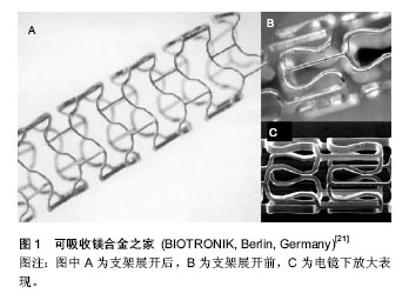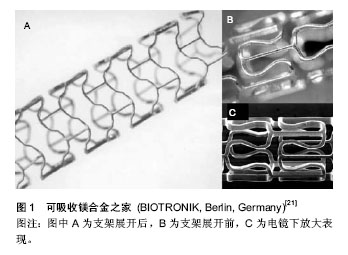| [1] Morino T,Kobayashi Y,Fujimoto Y,et al.Bare metal stent restenosis is benign clinical entity in Japanese patients.Int Heart J.2010;51(4):227-230.
[2] Rajagopal V,Rockson SG.Coronary restenosis: a review of mechanisms and management. Am J Med.2003;115(7): 547-553.
[3] 李禄丰,刘焕云,赵晓辉.可降解冠状动脉支架的应用现状[J].中国组织工程研究,2014(08):1270-1276.
[4] El-Omar MM,Dangas G,Iakovou I,et al.Update on In-stent Restenosis. Curr Interv Cardiol Rep.2001,3(4):296-305.
[5] Serruys PW,Kutryk MJ,Ong AT.DRUG THERAPY: Coronary-Artery Stents. NEJM.2006;354(5):483.
[6] Hong D,Saha P,Chou D,et al.In vitro degradation and cytotoxicity response of Mg-4% Zn-0.5% Zr (ZK40) alloy as a potential biodegradable material.Acta Biomaterialia.2013; 9(10):8534-8547.
[7] Chou D,Hong D,Saha P,et al.In vitro and in vivo corrosion, cytocompatibility and mechanical properties of biodegradable Mg–Y–Ca–Zr alloys as implant materials. Acta Biomaterialia. 2013;9(10):8518-8533.
[8] Zhao N,Watson N,Xu Z,et al.In Vitro Biocompatibility and Endothelialization of Novel Magnesium-Rare Earth Alloys for Improved Stent Applications.PLoS ONE.2014;9(6):e98674.
[9] Zhao N,Zhu D.Endothelial responses of magnesium and other alloying elements in magnesium-based stent materials. Metallomics.2015;7(1):113-123.
[10] Sternberg K,Gratz M,Koeck K,et al.Magnesium used in bioabsorbable stents controls smooth muscle cell proliferation and stimulates endothelial cells in vitro.J Biomed Mater Res B Appl Biomater.2012;100B(1):41-50.
[11] Onuma Y,Serruys PW.Bioresorbable Scaffold: The Advent of a New Era in Percutaneous Coronary and Peripheral Revascularization?Circulation.2011;123(7):779-797.
[12] Serruys PW,Garcia-Garcia HM,Onuma Y.From metallic cages to transient bioresorbable scaffolds: change in paradigm of coronary revascularization in the upcoming decade?Eur Heart J.2012;33(1):16-25.
[13] Heublein B,Rohde R,Kaese V,et al.Biocorrosion of magnesium alloys: a new principle in cardiovascular implant technology?Heart.2003;89(6):651-656.
[14] Erne P,Schier M,Resink TJ.The Road to Bioabsorbable Stents: Reaching Clinical Reality?CardioVascular and Interventional Radiology,2006;29(1):11-16.
[15] Di Mario C,Griffiths H,Goktekin O,et al. Drug-eluting bioabsorbable magnesium stent.J Interv Cardiol.2004; 17(6): 391-395.
[16] 李海伟,徐克,杨柯,等.可降解AZ31镁合金支架在兔腹主动脉的降解性能研究[J].介入放射学杂志,2010,19(4):315-317.
[17] Peeters P,Bosiers M,Verbist J,et al.Preliminary results after application of absorbable metal stents in patients with critical limb ischemia.J Endovasc Ther.2005;12(1):1-5.
[18] Bosiers M,Peeters P,D'Archambeau O,et al.AMS INSIGHT—Absorbable Metal Stent Implantation for Treatment of Below-the-Knee Critical Limb Ischemia: 6-Month Analysis.Cardiovasc Intervent Radiol.2009;32(3):424-435.
[19] Zartner P,Cesnjevar R,Singer H,et al.First successful implantation of a biodegradable metal stent into the left pulmonary artery of a preterm baby. Catheter Cardiovasc Interv.2005.66(4):590-594.
[20] Mcmahon CJ,Oslizlok P,Walsh KP. Early restenosis following biodegradable stent implantation in an aortopulmonary collateral of a patient with pulmonary atresia and hypoplastic pulmonary arteries.Catheter Cardiovasc Interv.2007;69(5): 735-738.
[21] Erbel R,Di Mario C,Bartunek J,et al.Temporary scaff olding of coronary arteries with bioabsorbable magnesium stents: a prospective, non-randomised multicentre trial.Lancet. 2007; 369:1869-1875.
[22] Waksman R,Erbel R,Di Mario C,et al.Early- and long-term intravascular ultrasound and angiographic findings after bioabsorbable magnesium stent implantation in human coronary arteries.JACC Cardiovasc Interv.2009;2(4):312-320.
[23] Ghimire G,Spiro J,Kharbanda R,et al.Initial evidence for the return of coronary vasoreactivity following the absorption of bioabsorbable magnesium alloy coronary stents. EuroIntervention. 2009;4(4):481-484.
[24] 邓国庆,禹正杨.医用可降解镁合金的研究进展[J].中国生物医学工程学报,2012,31(5):769-774.
[25] Zhou WR,Zheng YF,Leeflang MA,et al.Mechanical property, biocorrosion and in vitro biocompatibility evaluations of Mg–Li–(Al)–(RE) alloys for future cardiovascular stent application. Acta Biomaterialia.2013;9(10):8488-8498.
[26] Yang L,Huang Y,Feyerabend F,et al.Microstructure, mechanical and corrosion properties of Mg–Dy–Gd–Zr alloys for medical applications.Acta Biomaterialia.2013,9(10): 8499-8508.
[27] 崔新战,黄霞,关绍康,等.高分子材料涂覆生物镁合金心血管支架的研究与应用[J]. 中国组织工程研究,2012,16(51):9635-9639.
[28] Wittchow E,Adden N,Riedmuller J,et al.Bioresorbable drug-eluting magnesium-alloy scaffold: design and feasibility in a porcine coronary model. EuroIntervention.2013;8(12): 1441-1450.
[29] Wang J,He Y,Maitz MF,et al.A surface-eroding poly(1,3-trimethylene carbonate) coating for fully biodegradable magnesium-based stent applications: Toward better biofunction, biodegradation and biocompatibility.Acta Biomaterialia.2013;9(10):8678-8689.
[30] Guo M,Cao L,Lu P,et al.Anticorrosion and cytocompatibility behavior of MAO/PLLA modified magnesium alloy WE42.J Mater Sci Mater Med.2011;22(7):1735-1740.
[31] 郑玉峰,顾雪楠,李楠,等.生物可降解镁合金的发展现状与展望[J].中国材料进展,2011,30(4):30-43. |

